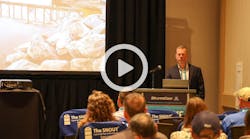“A cloak of loose, soft material, held to the earth’s hard surface by gravity, is all that lies between life and lifelessness” is a Wallace H. Fuller statement from his book Soils of the Desert Southwest with which William Young, RLA, PWS, ends his email signature. Young, a wetland scientist, has spent more than 30 years working to sustain that earthen material as a project manager, designer, and wetland specialist. He has developed expertise in large-scale habitat restoration on disturbed lands, wetlands monitoring and construction, natural resource inventory, forestry, wildlife assessment, mitigation and banking, and erosion and sediment control. He now works with USA Environment and is an adjunct professor at Temple University and the University of Pennsylvania, teaching sustainable practices and ecology.
A brownfield remediation project Young has been involved in over the past few years, entails some 100 acres along the Raritan River in Woodbridge Township, NJ, redeveloped for a natural-gas-fired electrical power plant. A public wetlands area features boardwalks and wildlife viewing areas. Young also wants to install wave attenuation devices (WAD) throughout the US coastline. “If you put up a retaining wall or a hard wall on the ocean or on the bay, all you’re doing is sending the energy to a neighbor,” he says. “WAD dissipate the wave energy and builds up the beach. This is going to save the Earth.”
What He Does Day to Day
Young has spent his days doing everything from working out of a kayak to consulting on clients’ sites. Sometimes he’s an advocate when a general contractor hasn’t thoroughly thought through site landscaping and restoration. When he’s not outdoors, he’s in the classroom teaching his experience in sustainability and professional practices.
What Led Him to This Line of Work
An aptitude test Young took as a high school senior pointed to an engineering career. Studying college choices, Young was attracted to landscape architecture. He had never heard of the profession—a concern echoed by his father—but was drawn to its combination of science, creativity, and working outdoors.
Young earned a B.S. in landscape architecture from State University of New York College of Environmental Sciences and Forestry, and an M.S. in urban design from Pratt Institute. He worked a few short-term jobs as a project manager and senior ecologist before working for Biohabitats as a wildlife ecologist.
He started his own company, Young Environmental, and performed wetland monitoring, design and build, and ecological restoration for more than a decade. Three years ago, USA Environment—a Houston, TX-based remediation firm—bought out his company, and he became a wetland scientist in its Edison, NJ, office, augmenting that work with teaching.
What He Likes Best About His Work
“I love everything I do,” says Young. “Some things are more mundane, redundant, and less rewarding, but on the whole, it’s a very interesting job. I’m outdoors a lot. It pays pretty well. I feel I have an impact on the Earth. I build wastewater treatment wetlands. How great is it that you can flush a toilet and it goes to a wastewater treatment plant, and then a secondary treatment through a wetland where people are walking on boardwalks, taking pictures of birds and alligators, and they don’t even know it’s wastewater treatment?” Additionally, “It doesn’t get any better than restoring wetlands on a contaminated site,” says Young. He strongly favors the WADS idea and hopes regulatory reluctance eases to make way for widespread adaptation.
His Biggest Challenge
Young says his biggest frustration is in not having equal standing in site-use planning. “Early on, I worked at landfills and the engineers were in control. We went hat-in-hand begging for things and never getting full credit,” he says. Young says he now works on projects where the engineers work for the ecologists.
Getting work can sometimes prove challenging, but Young sees environmental restoration as a viable, growing field. “The question is how do we get to the table to be up front in the negotiations and budget allocations?” he says. He also questions why more wetlands aren’t being constructed as buffers and filters. Same with wastewater treatment wetlands: “We can build a huge, expensive facility and use a lot of energy for treatment,” he says. “Or we can put plants in.”


